Michell Gyro SE Turntable—A Classic Revisited
you must believe in springs
The last time I checked in on a Michell turntable was back in 2000 with a review of the GyroDec SE. It's time for another review don't you think? This time it's the Gyro SE. The basic design strategy remains the same (though the original's Pabst A.C. motor has been replaced with a D.C. motor), so the big questions are: has the company maintained the high quality of the one reviewed twenty three years ago? And does the performance still hold up when inserted into a system vastly superior to the one back then? The "SE" stands for "spider edition", that is, instead of resting on a large acrylic base, the SE sits on a compact three point "spider".
In case you don't know the history of this storied company: Michell Engineering founder John Michell passed away in 2003 but not before establishing a chain of succession that kept Michell a family business. The company known as J A Michell Engineering began in 1973 as a contract-work based engineering organization. In that capacity, Michell built early versions of Transcriptors Hydraulic Reference turntables designed by the late David Gammon, seen in "A Clockwork Orange" and in other films and as a work of art in museums. The Hydraulic Reference's looks still get people ga-ga, but other than visual cool, I can't think of one good aspect of floating a record on six points and leaving it to resonate rather than damping it against a full contact platter.
Like SME's Alistair Robert-Aikman, John Michell was into building scale models, one of which was the space ship Discovery used in another Kubrick film, "2001 A Space Odyssey". But enough about side endeavors and company history. Today's J.A. Michell builds various iterations of the classic three spring suspended chassis design including multiple Gyro SE variants.
 The full lineup looks like this:
The full lineup looks like this:
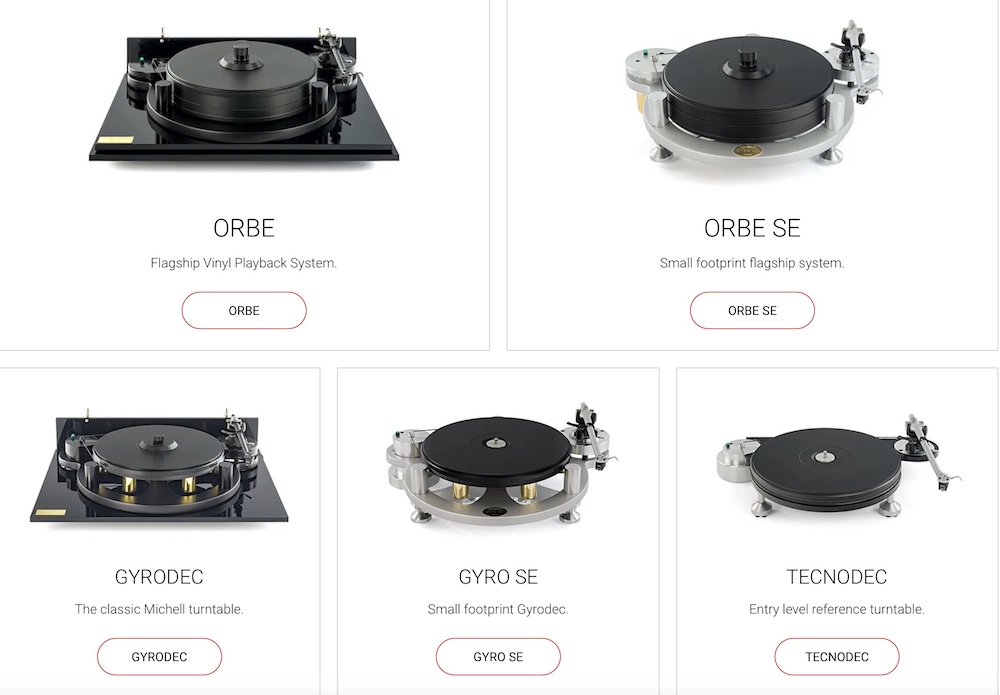
The one reviewed here looks like this one, which is a better photo than I can take with the review sample sitting on a Stillpoints SS rack in my utility room adjacent to the main listening room.
![]() The Michell website claims that "although the modern GyroDec may look very similar to the original 1980s design, the current Gyrodec is far more sophisticated. Everything from the motor and power supply to the platter and main bearing has been redesigned and improved to ensure the performance and reliability of the turntable remains class-leading."
The Michell website claims that "although the modern GyroDec may look very similar to the original 1980s design, the current Gyrodec is far more sophisticated. Everything from the motor and power supply to the platter and main bearing has been redesigned and improved to ensure the performance and reliability of the turntable remains class-leading."
That's since the 1980s. The design of the one sent for review now appears similar if not identical to the one reviewed in 2000 and the quality of the many parts that go into a Gyro SE appear to be at least as well, if not better made. The presentation and packaging (as I recall it, and I do!) are better. The current Gyro SE costs $3999 w/o arm— add $179.95 for a Rega 3 point mount arm board (you can have a board drilled and weighted for your choice of arms).
I was sent a new Michell TA8 arm with the 'table, directly from importer Fidelity Imports. It's a Rega supplied arm, I'd guess an RB330, with a Michell machined counterweight and perhaps rear stub and maybe it's been rewired but I'm just speculating (the cartridge clips look like Rega's). The arm costs $999.00
 According to Fidelity the 'table costs $5498 with Michell's Techno2 arm, which is a highly evolved Rega-based arm with its tube drilled out with 22 mass reducing holes, assembled using ultra-low friction polymer bearings, fully rewired with 99.9999 silver Litz wire, fitted to a VTA/SRA adjustable base and terminated with Michell's Technoweight counterweight.
According to Fidelity the 'table costs $5498 with Michell's Techno2 arm, which is a highly evolved Rega-based arm with its tube drilled out with 22 mass reducing holes, assembled using ultra-low friction polymer bearings, fully rewired with 99.9999 silver Litz wire, fitted to a VTA/SRA adjustable base and terminated with Michell's Technoweight counterweight.
 Also included was the HR9 PSU—an upgraded power supply ($999) for the 'table's D.C. motor, featuring speed adjustment and what Michell calls its "Never Connected" circuit (the supply is fully isolated from A.C. noise pollution). The upgrade is said to deliver a lower noise floor and better rhythmic "punch" and control. You don't have to buy the 'table with it, you can add it later.
Also included was the HR9 PSU—an upgraded power supply ($999) for the 'table's D.C. motor, featuring speed adjustment and what Michell calls its "Never Connected" circuit (the supply is fully isolated from A.C. noise pollution). The upgrade is said to deliver a lower noise floor and better rhythmic "punch" and control. You don't have to buy the 'table with it, you can add it later.
 Fidelity also sent a Michell Engineering Cusis C MC cartridge ($1999). It's the middle of the three cartridge Cusis line and features 30μ pure copper coils, a boron cantilever/Shibata stylus assembly in an "open bottom" Acetyl body, which shows a familiar Samarian-cobalt magnet based motor I correctly guessed was Benz-sourced. Output is .4mV, internal impedance is 4.5ohms.
Fidelity also sent a Michell Engineering Cusis C MC cartridge ($1999). It's the middle of the three cartridge Cusis line and features 30μ pure copper coils, a boron cantilever/Shibata stylus assembly in an "open bottom" Acetyl body, which shows a familiar Samarian-cobalt magnet based motor I correctly guessed was Benz-sourced. Output is .4mV, internal impedance is 4.5ohms.

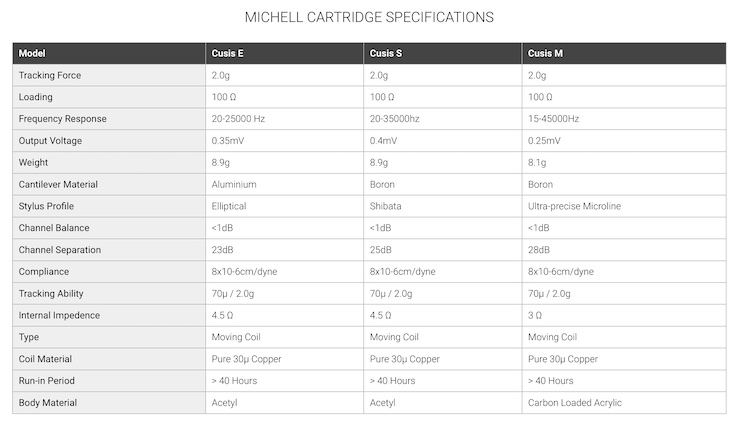
So, as delivered, the Michell Gyro SE as delivered with arm, upgraded PSU and cartridge costs $7996.
Classic Design
As Michell explains it on its website the design goal is to insure that "..the whole loop made by record, platter, bearing, (sub)chassis, arm plate, tonearm, and cartridge body should behave in an utterly rigid and non-resonant fashion."
Michell's three point spring suspension design is based upon a high mass sand-cast circular chassis into which is attached from below the main bearing—an inverted design featuring a case-hardened steel shaft with a modified Archimedean screw machined into the bearing housing's inside bore that as the bearing and platter rotate draws oil up from a reservoir at the main bearing's base to the thrust ball at the top, which fully lubricates the entire assemblage. The oil returns to the reservoir through a waste hole drilled into the bearing spindle. Fully lubricating with oil the entire bearing produces a "smooth ride" that seeks to avoid potential noise and vibrations. Setting it up requires filling a reservoir with the right amount of oil and then carefully sliding the bearing sleeve with ball in place over the spindle.
The design locates the point of rotation above the platter's center of gravity and precisely at drive belt height, which self-stabilizes the platter/bearing assembly and prevents rocking modes. A precision-ground soft round-section custom compound belt, runs around the platter’s circumference and of course the motor pulley.
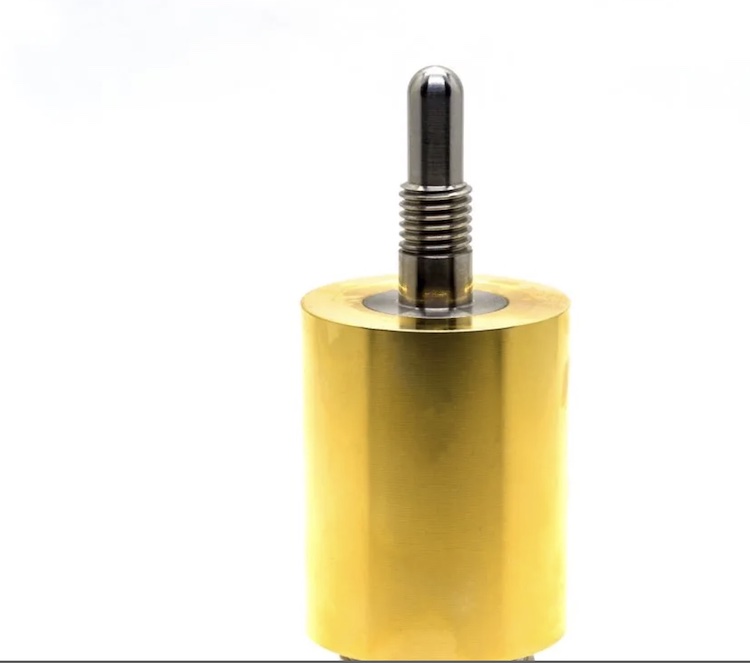 In the 2000 review I wrote "Assembling the 'table is not difficult, but diagrams and visual identification of the parts would make it much easier, especially for novices". Here there's both a much better set of instructions with photos plus at the bottom of this review is an embedded video that shows the entire process. The Gyro SE is not the easiest turntable to assemble but if you follow the instructions you should have no trouble doing it and once it's all assembled and working you'll derive an extra bit added satisfaction along with perhaps some greasy fingers.
In the 2000 review I wrote "Assembling the 'table is not difficult, but diagrams and visual identification of the parts would make it much easier, especially for novices". Here there's both a much better set of instructions with photos plus at the bottom of this review is an embedded video that shows the entire process. The Gyro SE is not the easiest turntable to assemble but if you follow the instructions you should have no trouble doing it and once it's all assembled and working you'll derive an extra bit added satisfaction along with perhaps some greasy fingers.
The three spring towers attach to the "spider" base and then once the outboard D.C. motor housed in a heavy base is carefully positioned and the chassis has been fully assembled—with the bearing and armboard/arm assembly in place—you carefully lower the now really heavy (but not so heavy that it's a more than one person job) chassis onto the three spring towers, followed by the twelve inch platter made of a proprietary self-damping compound of carbon/vinyl-loaded acrylic with its "trademarked" hanging gold-platted brass weights.
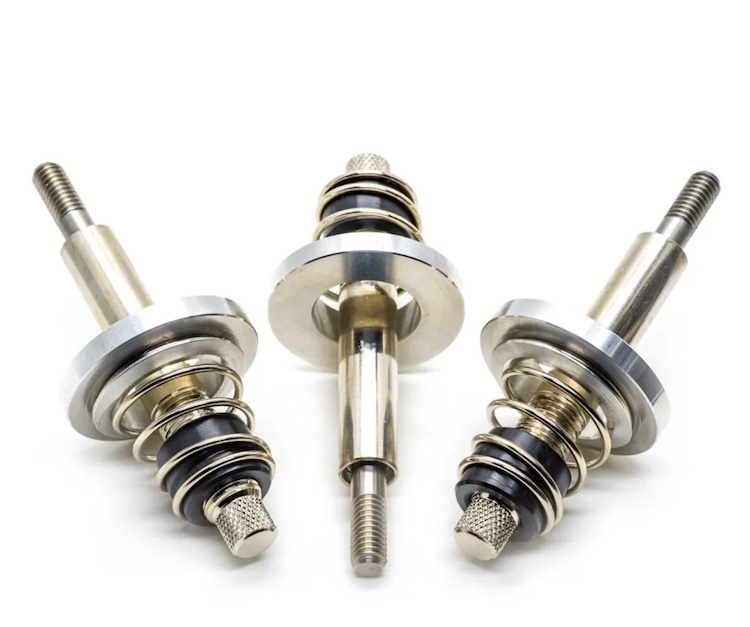
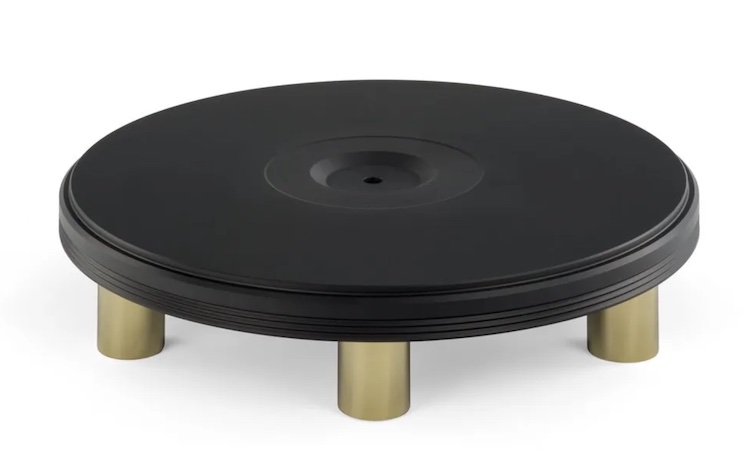 Now, the many parts start looking like a turntable! The motor, fully isolated from the chassis, fits through a large left rear corner opening. The arm, cartridge and platter are rigidly coupled together on the chassis, which has a total weight of approximately twenty four pounds and is isolated from the outside world by the suspension. The floating system's center of gravity is located well below the suspension points. Michell offers a wide range of "off the shelf" armboards for Rega, Linn, SME and Mørch arms precisely weighted to keep the mass and mass distribution of the chassis a known constant, which produces a stable suspended chassis design.
Now, the many parts start looking like a turntable! The motor, fully isolated from the chassis, fits through a large left rear corner opening. The arm, cartridge and platter are rigidly coupled together on the chassis, which has a total weight of approximately twenty four pounds and is isolated from the outside world by the suspension. The floating system's center of gravity is located well below the suspension points. Michell offers a wide range of "off the shelf" armboards for Rega, Linn, SME and Mørch arms precisely weighted to keep the mass and mass distribution of the chassis a known constant, which produces a stable suspended chassis design.
Since the supplied armboard is specifically weighted for the arm and the combination is intended to produce ideal weight distribution across the three point suspension, you automatically achieve close to pistonic "up and down" motion if you press down on the platter. Michell says it's not essential to achieve it to get effective system performance and I believe them but if you do wish to tweak you can adjust individual spring tension and try to get it perfect, which or course I did. It wasn't that far off unadjusted but I felt better after the bounce was just about perfectly vertical.
Once I was finished there i found that banging on the Stillpoints rack shelf did not at all phase the stylus as it ran through the grooves, nor did it produce any sound through the speakers. The suspension works as designed and without the need for obsessive adjustments or any adjustments actually. Im sure if I did the AR test a hammer blow wouldn't have phased the Gyro SE either!
 I'll skip the rest of the set-up process because you can watch the video below if you are keenly interested. There are both similarities and differences between the GyroDec first introduced in 1982 and the Oracle Delphi introduced in the late 1970s. Today of course, though the Oracle and Gyro SE have a similar design concept, the Gyro SE is priced far lower than the Oracle—not that I'm suggesting a comparison.
I'll skip the rest of the set-up process because you can watch the video below if you are keenly interested. There are both similarities and differences between the GyroDec first introduced in 1982 and the Oracle Delphi introduced in the late 1970s. Today of course, though the Oracle and Gyro SE have a similar design concept, the Gyro SE is priced far lower than the Oracle—not that I'm suggesting a comparison.
I mounted the Cusis S cartridge and set tracking force and anti-skating. Since the arm doesn't offer azimuth or VTA/SRA adjustments I didn't look to see or measure what the cartridge produced because a buyer will almost certainly not check those things. Why obsess over what you cannot adjust? But I checked azimuth anyway using the Fozgometer 2 and the crosstalk between the channels (L-R and R-L) was within a tiny fraction of identical.
Sonic Performance
Every turntable design scheme has pluses and minuses. Proponents of either suspended or non-suspended turntables talk up their positives and omit their negatives. It's like dating (I remember). The suspended design's main negative is that even if the suspended part containing the arm and platter is rigidly coupled together and the motor is fully isolated on its own platform, any lateral platform movement will vary the distance from the motor to the platter, which inevitably affects belt tension and thus speed stability. Suspension tuning is critical to minimize this problem.
Eccentrically pressed records causes the arm to sway even minutely back and forth, which can induce softly sprung suspensions that are effective at isolation, to produce "porch rocker" effect, which can vary platter to motor distances and thus negatively effect speed consistency. Non-suspended turntable advocates point to that as the reason suspended turntables can sound "soft". Suspended turntable advocates point to the outstanding isolation and quiet and around and around it goes!
After spending a great deal of time listening to and enjoying the sonic performance of this Gyro SE, I'd say it produces an ideal balance between effective isolation from the outside world and excellent belt drive speed consistency. Before breaking it down I measured performance using the Shaknspin app and got this result:
 These are decent belt drive results but as a point of reference, the SAT direct drive turntable (which, with arm sells for around $300,000) has a DEV:00.07%. On the other hand, the recently reviewed, similarly priced Holbo, which also is belt driven had a DEV:-1.13%, which is not quite as good as the Gyro SE and it is non-suspended.
These are decent belt drive results but as a point of reference, the SAT direct drive turntable (which, with arm sells for around $300,000) has a DEV:00.07%. On the other hand, the recently reviewed, similarly priced Holbo, which also is belt driven had a DEV:-1.13%, which is not quite as good as the Gyro SE and it is non-suspended.
So how does this Gyro SE sound— fitted with the new TA8 arm and Claris S cartridge? I thought the bottom end performance was tighter, faster and somewhat cleaner and punchier than that of the Holbo. And based on what I wrote in the 2000 review, this Gyro SE has an improved and punchier bottom end. The mid bass bloom I noted back then was pretty much absent here.
I've been comparing pressings of Jazz Samba (Verve V6-8432) for a video review of multiple records in the Acoustic Sounds/Verve series including the newest one cut by Ryan Smith from the original tapes as well as my original pressing from 1962, one cut by Kevin Gray for Speakers Corner I forget the year, the Analogue Productions double 45 cut by George Marino and the new one. I love the record and can endlessly play it. It's a jazz essential IMO and after evaluating these pressings on the Gyro with multiple reasonably priced phono preamps including the just reviewed $249 Spinstage, I felt confident I could describe the differences and pick a favorite. When I repeated the exercise on my reference turntable and phono pre, of course there was more there but the results were the same.
The Gyro SE fitted with the Cusis E added up to a very low coloration front end that had very good bass extension, cleanly rendered and "fast". The overall timbral balance was supremely neutral and backgrounds were, as expected from a properly implemented suspended design, supremely black. I played the new Original Source DGG Schubert Trout Quintet with Gillels and the Amadeus Quartet (DGG 486 3848) and was especially impressed by the clarity and weight of the double bass as well as the image stability and soundstage three-dimensionality. The piano sound was remarkably coloration-free and the attack subtle and believably "piano-like", thanks also in part to deft micro-dynamics. Even if you think you don't like chamber music, you might like this!

What he said in that 2000 review: "You'll find snappier performance and speedier transients from some non-suspended 'tables, but you won't get from them the luscious, airy mids offered by the GyroDec SE and other suspended 'tables, or the GyroDec's impressively black backgrounds—not at this price." That was then, now I'd say I wouldn't want "snappier performance" or "speedier transients". This was just right.
How about rock'n'roll? I tried to twist the thing in knots with Mo-Fi's bass-heavy/high frequency pushed Sticky Fingers (MFSL-1-060). It's fun for sure but cartoony fun. Here, the minor dynamic and low frequency limitations revealed themselves but the funny thing is, they made this mastering more tolerable and less cartoony and there was sufficient well-carved bottom to make the play enjoyable.
I'm through complaining.
Conclusion
There are easier turntables to set up but if you follow the instructions—now with photos— I'm sure you'd have no trouble. You'll be rewarded with a fine performing, supremely well-isolated deck whether or not you choose the TA8 arm and Cusis S cartridge. Whatever cartridge and arm do you choose, you'll be hearing it and not this 'table. Whatever are the Gyro SE's issues, they are of omission not commission. Michell supports a wide variety of arms with "off the shelf" properly weighted armboards and can supply one for pretty much any arm you choose.
I spent a great deal of time listening to the Michell Gyro SE fitted with the Cusis S cartridge and while far more costly and higher performance turntables were in the room, not once did I feel I was paying a sonic price because the Gyro SE did so much right and really didn't do anything wrong. If you have the opportunity to hear one, be sure to give it a spin before you buy anything in the under $10K price point. In a better world I'd have all the competition to compare it to and report back, but I don't. That said, I'm pretty confident saying if you choose the Gyro SE you won't regret the purchase.
Specifications
Weight10kg
Width49cm
Depth37.5cm
Height13.5cm
Manufacturer Information
J. A. Michell Engineering Ltd
Unit B
Gateway 1000
Arlington Business Park
Whittle Way
Stevenage. SG1 2FP











































